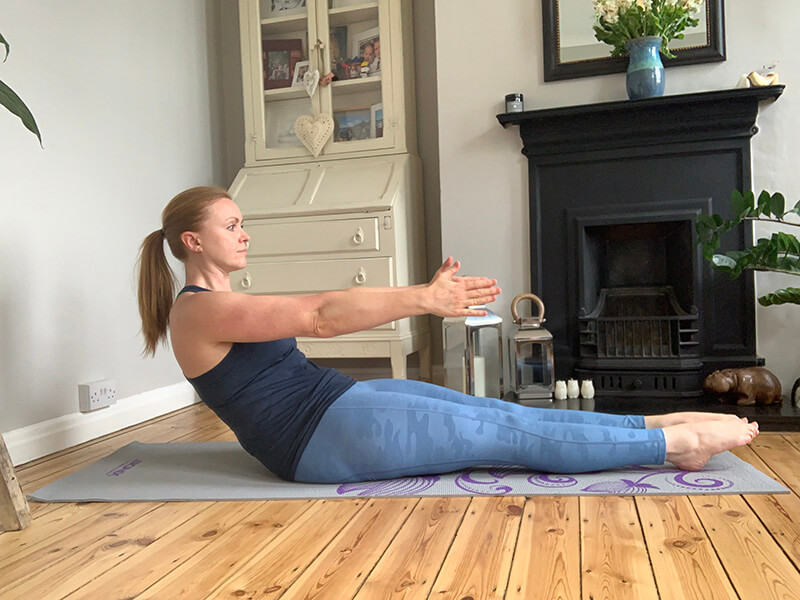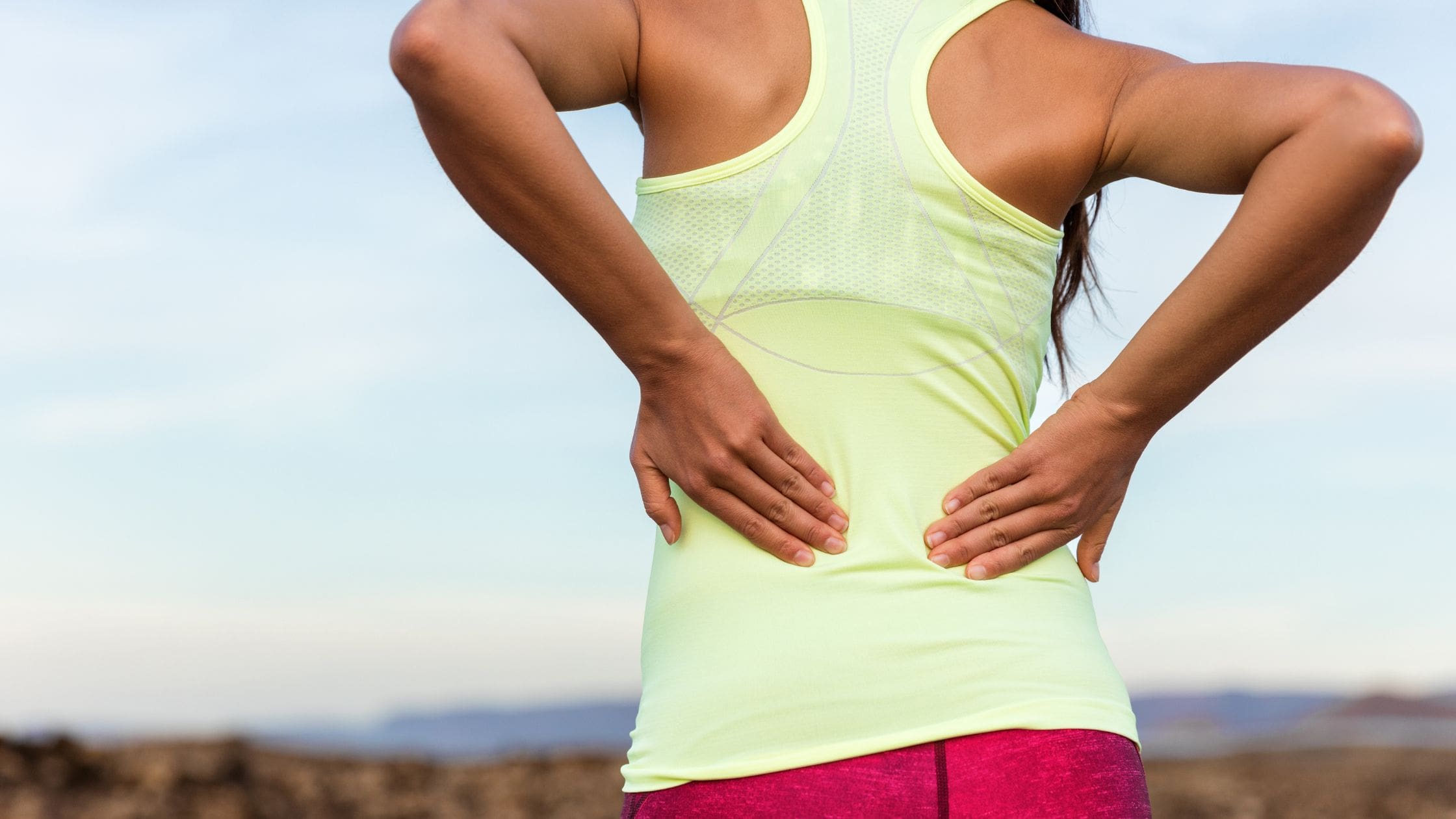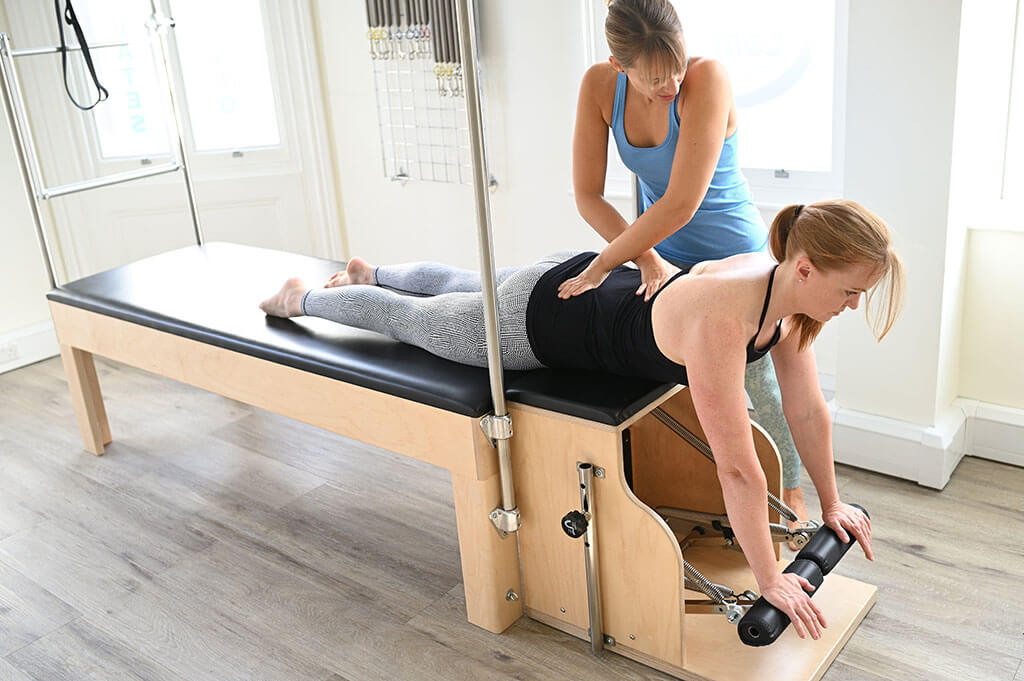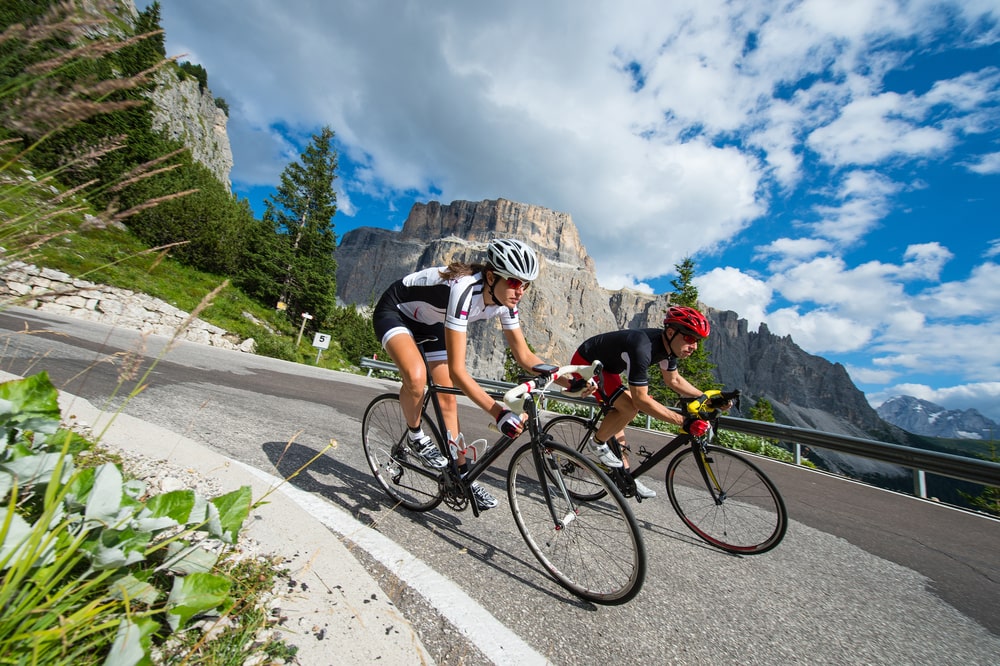Key Contributor: Alex Wachter, Clinical Pilates Instructor, Training Osteopath
The Pilates Roll Up is a staple of Pilates mat classes. If you attend them regularly, you’ll have performed this exercise (and variations of it) plenty of times.
This is because the Roll Up is considered a basic Pilates exercise. But don’t confuse “basic” with “easy”. This move is a real challenge for the abdominal muscles and much more effective than traditional crunches. To successfully achieve this exercise also requires flexibility, strength and the coordination of breath and movement. This is not just a beginner Pilates exercise!
For the above reasons, the roll up can be a difficult exercise to get right. Common mistakes include letting your legs lift off the ground, gripping through the hips or relying on momentum to get you up. But by using the tips and instructions below, you’ll learn how to master the Pilates Roll Up so that you can reap the benefits.
What is the roll up exercise?
The roll up exercise is just what it sounds like! You start lying on the floor and roll yourself up into a sitting position. However, it doesn’t just end there – it could also be called the ‘roll down’ since rolling back down from sitting to lying is also part of the exercise and requires eccentric strength in the abdominals and hip flexors (note: eccentric means that the muscle is lengthening under tension, rather than contracting and shortening).
The roll up differs from other abdominal exercises in that it combines spinal mobility and breathing control with strength.
Many people who have strong abdominals may also create a lot of rigidity in their torso and these folks can really struggle with the roll up exercise.
Tensing the abdominals hard, bracing the abdominals, or holding your breath are all strategies that prevent the spinal mobility necessary for the roll up exercise.
How to do the Pilates Roll Up
- Start by lying on your back on the floor with your legs straight. Bring your arms in an arc overhead until they are flat on the floor behind you. Your head should now be resting between your arms. If you find this position uncomfortable, reduce your range of movement and keep your arms hovering above the mat.
- Inhale to prepare. Exhale and bring your arms overhead in an arc. When the arms move past 90 degrees, start to curl your head, neck and shoulder blades off the mat. This part of the exercise looks like the starting position of the Pilates Hundred.
- Inhale again here and exhale as you roll up the rest of the way. Focus on the sensation of your ribs sliding towards your pelvis as you do so.
- As you continue to roll through the spine, imagine a ball nestled in your stomach and move around it – this should help your spine find a deep rounded shape.
- Once you’ve curled all the way up, pause with your fingers stretching towards your toes, maintaining your spine in that “C” shape. Remember: don’t allow your arms to drop. Instead, keep them lifted and parallel to the floor.
- Now, inhale to extend your spine from the pelvis up through your lower spine, middle spine, neck and head until you are sitting on your sit bones. These are the bones in your butt cheeks.
- Exhale and roll back to the starting position.
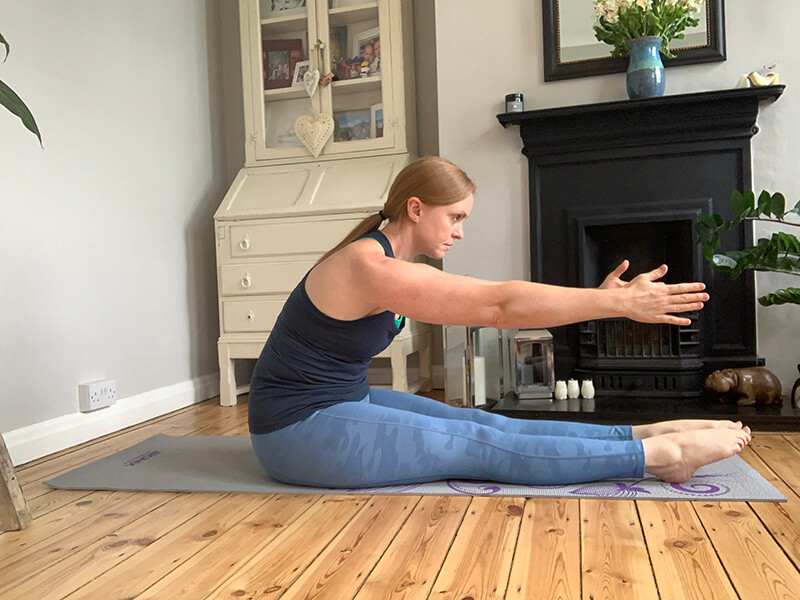
What do our experts say?
The Pilates roll-up exercise is a go-to for so many reasons; it’s threefold when I introduce it into sessions. It is great for improving spinal mobility if you’re suffering from back pain or feel a general day to day restriction or stiffness in the back. If you’re struggling to find good abdominal control in other exercises like chest lift on the mat, the roll-up is a great alternative, especially using studio equipment. If you’ve had a particularly stressful day or big weekend, the roll-up can provide a stress-relieving effect, tuning into your nervous system promoting relaxation and better digestion through deep breath work. Alex Watcher.
People who should avoid this exercise
People with an acute disc pathology, acute cervical pathology or osteoporosis.
Pilates roll up exercise: Benefits of the Roll Up
If you want to strengthen your abdominals, the Roll Up is the exercise to choose. According to researchers at Auburn University in Montgomery in Alabama, the Roll Up is 30 percent more effective than simple crunches. This is because of the way it targets the rectus abdominis (the six-pack muscles) and recruits more muscle fibres.
Aside from strong abdominals, the Roll Up exercise is an effective way of increasing the flexibility of your body by improving hip flexor length and mobilising your spine. This is important because an inflexible body can lead to pain; it also makes your movement less efficient. Plus, a stiff spine leaves your back vulnerable to injury. Regularly practising the Roll Up, however, can help you avoid these problems.
On top of all that, the Roll Up promotes deep breathing and better circulation. In combination with the massaging effect of the exercise on the stomach organs, this gives your digestive system a boost.
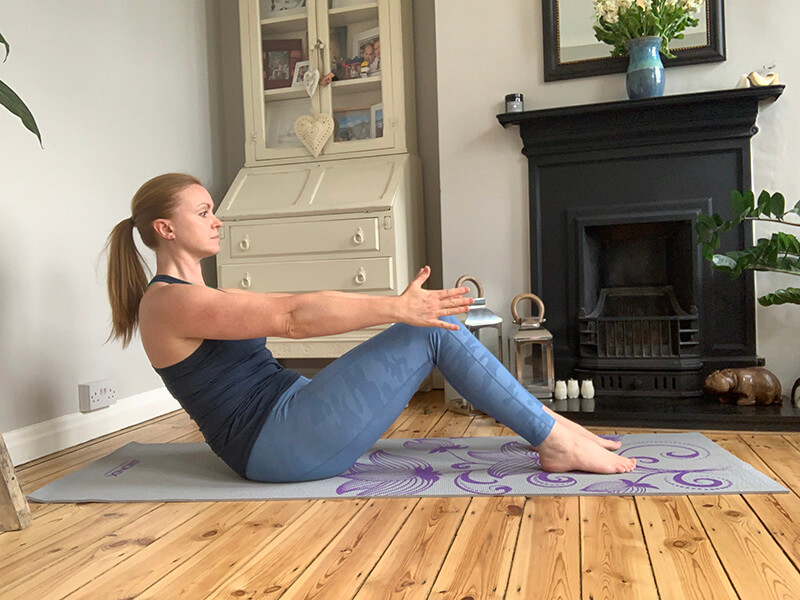
Pilates roll up Modifications and variations
Pilates roll up: legs bent
Performing the Pilates Roll up with the legs bent is an easier variation to start with. You can place the hands behind the thighs as you sink into a ‘C’ curve, allowing you to find this shape in a supported position. If you have tight hamstrings aka, can’t touch your toes, you will find this position much easier than the straight leg version.
Pilates roll up: legs straight
The full roll up can be performed with the legs straight. This variation can give you more weight in the legs to counterbalance your upper body but it can be hard to hold the legs here. This variation is great if you tend to get a lot of tension in the strong hip flexor muscles at the hip crease.
Pilates roll up: with a partner!
Having a buddy can be a great way to work on your roll up. A partner can help you hold your feet down on the floor so that you have more stability and. A partner could also assist with your arm movements – they can take you lightly by the hands and then guide your hands up, overhead and forwards. This will allow the rest of your body to follow the movement of your arms, and takes some of the load off your abdominals.
Pilates roll up: using a strap
In this variation of the roll up, you loop a strap or a resistance band around your feet and hold both ends with your hands. This gives you lots of support to help you up as you roll up off the mat.
Pilates roll up: on a trapeze table
The large Pilates equipment can help you master the Pilates roll up. Performing the roll up on the trapeze table is similar to having a partner assist you up (and doesn’t require pulling on your poor pal). Holding on to the dowel, attached to springs, gives you a helping hand to get up off the table.
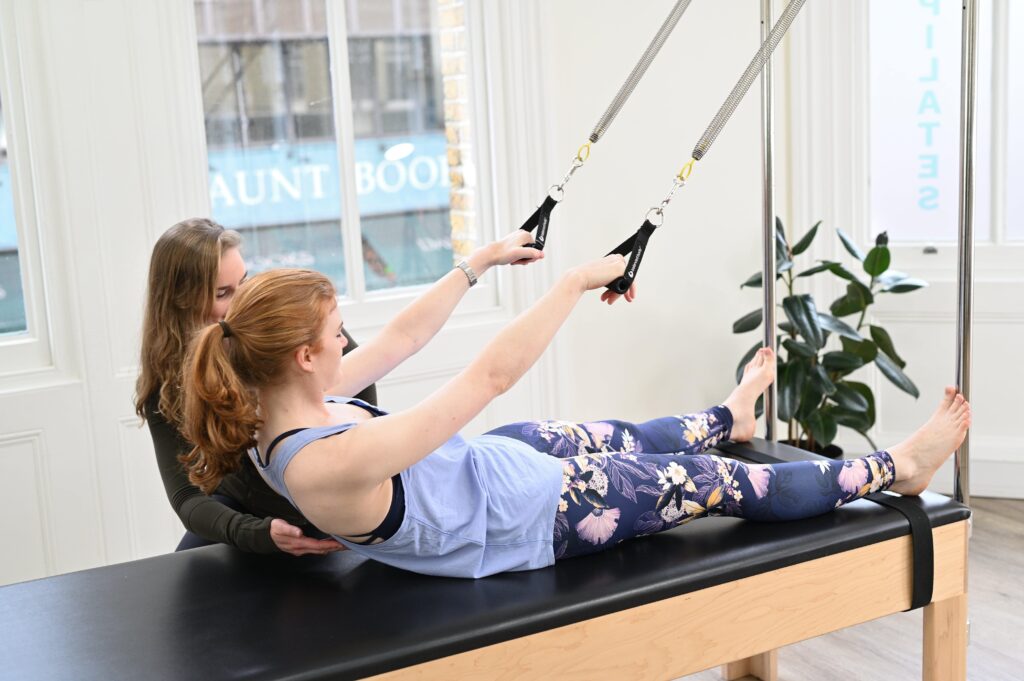
Pilates roll up: on a reformer
The Pilates reformer is another great way to work on your roll up. The weight of your upper body can be supported by holding onto the reformer straps. Sitting on the moving carriage is a great way to work on the mobility of your lower back. As the carriage moves forward, it does the work of rolling your into a ‘C’ shape, rather than you having to do the work yourself.
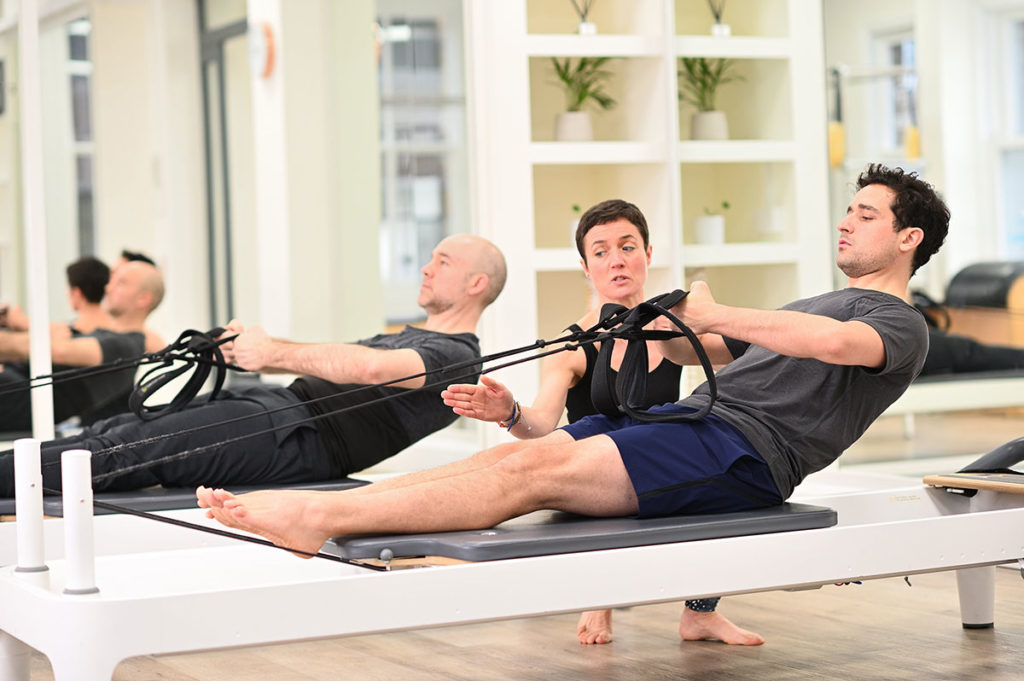
Holds and pulses
If you’re pretty good at the roll up already and you want to add some spice – try stopping at intervals on the way down and holding for 5 seconds. If you are still not feeling the challenge – add some pulses to feel the burn.
Add weights
Holding dumbells in your hands as you perform the roll up will increase the challenge and your strength.
Top tips to help your roll up
Difficulty Rolling Up
The Roll Up requires your pelvis to move between neutral and tilted. Despite this, you shouldn’t be over-tucking the pelvis or pressing your lower back into the mat during this exercise. Doing so will make it harder to get up in the initial phase.
- Practising pelvic tilts can improve this aspect of the exercise.
- Create a smooth curling movement of the spine by imagining a wheel turning on the side of your pelvis.
- Using full inhales and exhales as you move will also make the roll up easier.
Lifting your legs or gripping in your hips
If you find that you are over-using your hip flexors or that your legs are lifting off the ground as you move, try these three modifications.
- Take the two ends of a resistance band into your hands and loop them around the soles of your feet. Use it for support as you roll up and down.
- Bend your knees instead of keeping them straight during the exercise. This can stop the over-activity of the hip flexors. It is also more comfortable for those with hamstring limitations.
- With your knees bent, reach your hands to the back of the thighs. Now, use the strength of your arms to aid you as you roll up.
How to make the Roll Up more challenging
Using the magic circle prop during the Roll Up adds challenge and incorporates more muscles into this exercise.
Try it: add it to your Roll Up by taking the magic circle between the palms of your hands. Keep your arms straight as you gently squeeze the circle and maintain this pressure as you roll up and down. This will engage various parts of your upper body, including your lats, shoulders, chest and arms.
If you are still struggling with the Pilates roll up, why not get in touch or book our offer.
Summary
Do you need direction when it comes to the Pilates roll-up exercise? At Complete we specialise in 1-2-1 equipment-based Pilates for rehabilitation. Come and check out the ways in which we can help you work on the rolldown.
Try a studio class of Pilates in North London or 1-2-1 session with Complete Pilates at any of our studios? You can also visit us at our Pilates studio in Chelsea or do Pilates in the City of London.
Education is key:
These blogs are designed to give information to everyone, however, it is important to remember that everyone is different! If you have not seen one of our therapists and have any questions about injuries, what you have read or whether this may be useful to you, please just ask. We are more than happy to help anyone and point you in the right direction. Our biggest belief is that education is key. The more you understand about your injury, illness and movement, the more you are likely to improve.


